Let's be real – we buy beauty products for their contents, not their containers. I mean sure, we’re all swayed by aesthetic packaging, but is it worth the environmental cost? Plus, sustainable packaging can be just as cute minus the planet destruction. And honestly, there's nothing cute about marine life paying the price for our plastic obsession.
The beauty and skincare industry churns out a staggering 120 billion units of packaging annually. Around 80% of that ends up bobbing in our oceans or languishing in landfills. If we stay this course, by 2050, our oceans will contain more plastic than fish. I don't know about you, but I'm not snorkeling to socialize with discarded plastic.
How does plastic end up in the ocean?
Our oceans have become the planet's garbage dump, collecting trash from all corners. Most of it is blown in from coastlines or swept from landfills into rivers, which act like conveyer belts depositing waste into the sea. The rest is lost cargo from ships and abandoned commercial fishing gear.

Why should we care about plastic in the ocean?
Well, in the oceans, plastic is a killer. Hundreds of thousands of marine animals and fish are ensnared and trapped in plastic waste every year. They're hurt, immobilized, or infected, and there's no emergency room in the ocean's dark depths to rescue them.
Secondly, marine life, birds, and other creatures unknowingly eat vast quantities of plastic, often mistaking it for food. And the real villain? Microplastics - tiny plastic particles that affect species all across the food chain.
And most concerning to us humans, plastic absorbs toxins from landfills and contaminants in the sea. When animals eat this plastic, they ingest these toxins. And guess what? When we eat these animals, we're eating those toxins too (along with every other animal along the food chain).

How much plastic is in the oceans?
Plastic has invaded every nook and cranny of our planet's oceans, reaching even the mysterious depths of the Mariana Trench. Maybe you’ve heard of the Great Pacific Garbage Patch, a floating trash island 3x the size of France? Well there’s at least 5 of those floating around. Over 5 trillion plastic pieces float in our waters. And the price? The lives of a million seabirds and 100,000 marine animals every year.
But isn’t most plastic being recycled? How is it in the ocean?
Sadly, the recycling industry isn't all it's cracked up to be. Only 9% of the world’s plastic has ever been recycled. And that’s not for lack of trying – most consumers throw their used plastic in recycling bins but over 90% of that plastic still ends up in the landfill.
But why aren’t recyclables being recycled??
While all plastics bear recycling symbols, most are made from unrecyclable plastics. Only #1 and #2 plastics can potentially be recycled, but these too usually end up in the landfill.
Why this is: before 2018, we used to sell our recyclables to China, meaning there was monetary incentive to move plastics through the recycling chain. After 2018, China stopped buying recyclables, taking away our biggest buyer of post-consumer plastics.
Now that we're handling our own recycling, we've realized most of it is either extremely difficult or impossible to recycle. And it turns out China wasn’t able to recycle most of it either – they were sending the majority of it to the trash.
So, now we’re left with a small number of domestic buyers who purchase recycled plastic and sell it to manufacturers. But that doesn't work well either because virgin plastic is often cheaper than recycled plastic, leading manufacturers to opt for the former, leaving recycled plastic to be dumped in landfills or incinerators.
So what is being done to fix this?
Though it might seem overwhelming, there is hope. Major projects are underway to clean up the plastic already in the ocean and prevent more from entering. The Ocean Cleanup, for example, has invented a floating device to extract plastic from the Great Pacific Garbage Patch. Meanwhile, Chinese researchers have developed a surveillance system to track river plastic before it reaches the ocean. Even from space, the European Space Agency is using satellites to track plastic waste, nudging governments to limit plastic pollution.
On a smaller scale, many local governments are banning single-use plastics from grocery stores, fast food chains, and convenience stores. Plastic straws and plastic cutlery seem to be on the way out for good.
No matter how effective these solutions are though, the only true solution is to kick our plastic habit once and for all. That means both shopping for zero-waste products and urging governments and big companies to ditch plastic packaging.
So, what else can we do as individuals?
A lot, actually! We can vote with our wallets and choose plastic-free, waste-free products. Our choices drive demand, and companies will create more of what sells. Let's create a plastic-free wave!
To help get you started, we’ve rounded up our favorite sustainable, earth-friendly personal care products. Browse our favorite sustainable kitchen swaps here.
Our favorite zero waste skincare swaps
Organic Cotton Facial Rounds
Replace 1000 throwaway cotton pads with these sumptuously soft organic cotton facial rounds that are as good for your skin as they are for the planet.

Blue Heron Botanicals Lip Balms
Made with 100% natural and organic wildcrafted ingredients, our deeply nourishing, insanely hydrating lip balms are packaged in compostable zero-waste packaging and produced in our Founder’s solar-powered off-grid property in Northern California.
Have your all day-hydration and save the planet while you’re at it!

Tattoo Aftercare Balm
Handcrafted in California and enriched with deeply restorative, healing botanicals, our Tattoo Aftercare Balm will heal your tattoo 3x faster – reducing itch, preventing infection, and nixing scabbing. Made with our signature zero-waste compostable packaging, it’s as good for the Earth as it is for your new ink!

Reusable Double Edge Razor
Say bye to underperforming (and wasteful) disposable plastic razors and hello to your sleek matte black reusable razor that leaves no hair behind.

Soap Saver Organic Cotton Pouf
Most shower loofahs and sponges are made from plastic or nylon – they shed microplastics in the water which ultimately ends up in the ocean and in your water glass. Instead of scratching your skin (and hurting the planet) with plastic, lather up in sustainable style with a luxe organic cotton pouf that doubles as a soap holder and feels like a spa day every day.
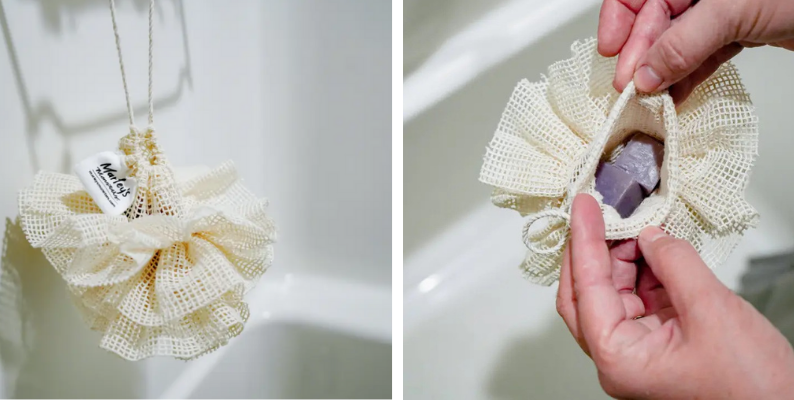
Toothpaste Tablets
Down with wasteful plastic toothpaste tubes! Up with adorable zero-waste toothpaste tablets made from refreshing natural ingredients that clean, whiten, fight plague, and freshen your teeth and breath. Encased in a refillable aluminum case.

Konjac Sponges
The ultimate exfoliator made from Japanese Konjac vegetable roots! Enriched with green tea extract, these all natural and biodegradable sponges combine antioxidants with physical exfoliation for bright, hydrated, happy skin. 100% compostable and package-free!
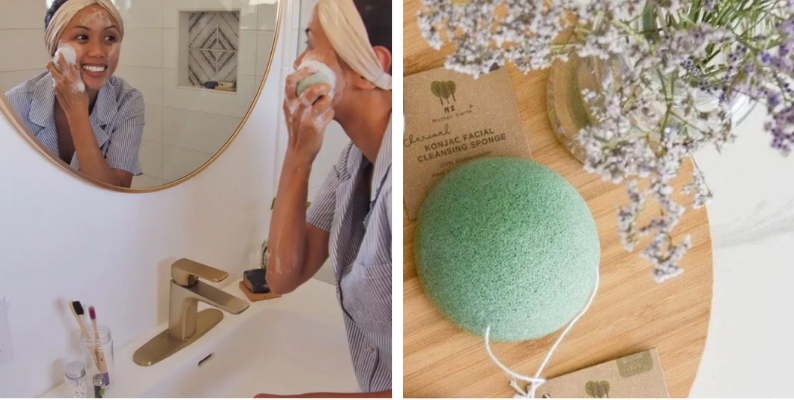
Bamboo Washcloths
These sumptuously soft bamboo washcloths are super absorbent and feel positively delicious on your skin. Bamboo requires less energy, water, and space to grow than cotton, making them a more sustainable (and softer) selection.

Serum Jelly Serum Bar
If you’re a skincare gal, you know the power of a good serum. The only downside? That unrecyclable dropper that most of them come with. Enter: the solution – a highly concentrated, deeply nourishing serum in bar form!
Packed with vitamin C for brightening, calming flora compounds to reduce redness and smooth texture, and amino acids + squalene for deep down hydration. Get your glow on minus the waste.
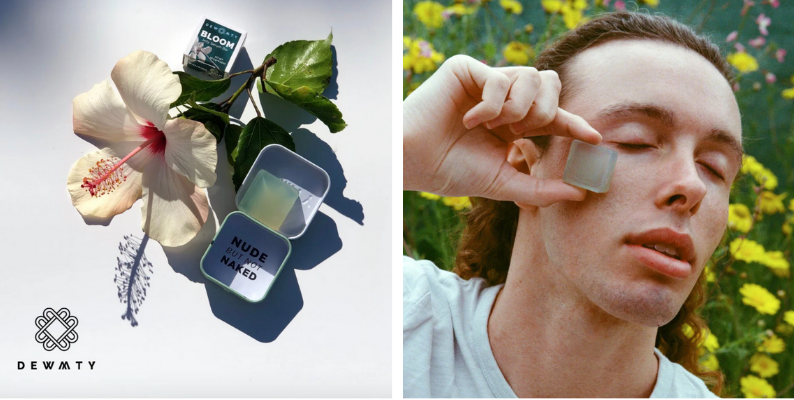
Axiology Lip-to-Lid Balmies
Sustainability is all about multi-use magic! Find products that do more so you can buy less – a win-win for you and the planet! Axiology’s award-winning balmies give a deliciously hydrating pop of color to lips, lids, and cheeks for an all over glowy flush that says summer in St. Tropez. Made with fully recyclable paper packaging.
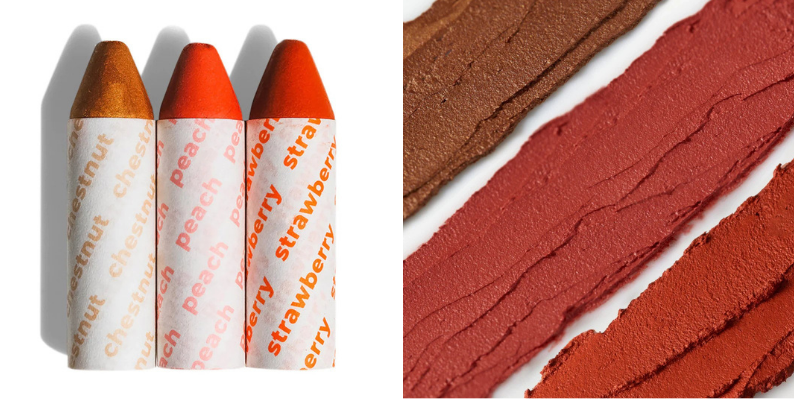
Eco Dental Floss
Did you know most dental floss is made from nylon or Teflon? Yes, the same Teflon that coats your non-stick pan.
Instead of rubbing Teflon on your teeth, opt for this biodegradable bamboo charcoal floss with a refillable glass container. Unlike Teflon and nylon which will live forever in landfills and our oceans, this eco floss will biodegrade in 60-90 days – just toss it in your backyard compost pile and watch it disappear.

Beechwood Travel Hairbrush
Out with wasteful plastic hairbrushes and in with this sumptuously sustainable hairbrush made from sustainably sourced, FSC certified beechwood, a natural rubber cushion, and bamboo pins. Treat your tresses and love on the planet all at once.
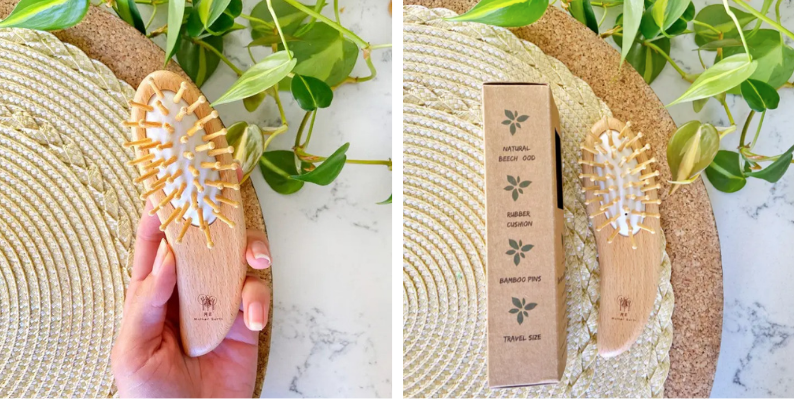
How we do zero-waste at Blue Heron Botanicals
Packaging
We’re all about doing right by the planet. Our packaging is 100% biodegradable and compostable. Every tube is made from recycled paper, and our labels? Straight from sugar cane fiber! You can compost it all in your backyard.
Ingredients
We wave goodbye to harmful, ocean-killing substances like microplastics, oxybenzone, EDTA’s, PFA’s, and PFC’s, silicones, and Teflon found in many cosmetics. Instead, we embrace locally-sourced, certified organic, and sustainably harvested ingredients, free of synthetic additives.
Many of our ingredients are grown and hand-picked at peak potency on our Founder, Theora's off-grid property.
Production
Every product we offer is handcrafted and packaged in our Founder, Theora’s solar-powered off-grid sanctuary in Northern California. We are literally powered by the sun!
Giving Back
With every product purchased, we save a baby sea turtle hatchling and eliminate plastic waste from vital nesting beaches. Our products are not just plastic free, they're part of our mission to protect marine life most impacted by plastic pollution.
So far, we’ve rescued 84641 sea turtles and swapped out a whopping 108289 units of conventional plastic packaging with our zero-waste compostable alternatives.





